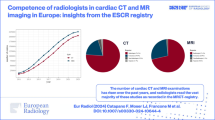Abstract
Purpose: Detection of coronary artery disease (CAD) with magnetic resonance imaging (MRI) using adenosine stress first pass perfusion in patients with aortic stenosis in comparison with invasive angiography. Twenty-three consecutive patients (15 male, mean age 68 ± 12 years) with relevant aortic stenosis (aortic valve area 0.90 ± 0.41 cm²) were examined by MRI (1.5 T, Philips Intera CV™). Contrast-enhanced first pass perfusion was performed with adenosine stress (140 μg/kg/min) and under rest conditions. The results were compared with invasive coronary angiography with regard to the presence of a relevant coronary artery stenosis (>70%). Three of 23 patients (13%) had contraindications for adenosine administration (one patient with atrioventricular block, two patients with mild claustrophobia). In the remaining 20 patients, adenosine stress perfusion could be performed without any complications. CAD was correctly detected in eight patients and correctly ruled out in 10 of 12 patients. False-positive results were seen in two patients with severe myocardial hypertrophy. Sensitivity, specificity, positive predictive value, and negative predictive value were 100%, 80%, 83%, and 100%, respectively. Adenosine stress perfusion can be performed without complications even in patients with high grade aortic stenosis. MRI is helpful to detect and rule out significant CAD in these patients. Severe myocardial hypertrophy may lead to false-positive results. Our initial results indicate that due to a high negative predictive value pre-operative invasive coronary angiography might probably be waived in patients without perfusion defects in stress MRI.


Similar content being viewed by others
Abbreviations
- AVA:
-
Aortic valve area
- MRI:
-
Magnetic resonance imaging
- SSFP:
-
Steady state free precession
References
Lindroos M, Kupari M, Heikkila J, Tilvis R (1993) Prevalence of aortic valve abnormalities in the elderly: an echocardiographic study of a random population sample. J Am Coll Cardiol 21:1220–1225
Iivanainen AM, Lindroos M, Tilvis R (1996) Natural history of aortic valve stenosis of varying severity in the elderly. Am J Cardiol 78:97–101
Iung B, Baron G, Butchart EG et al. (2003) A prospective survey of patients with valvular heart disease in Europe: the Euro Heart Survey on Valvular Heart Disease. Eur Heart J 24:1231–1243
Bonow RO, Carabello BA, Kanu C et al. (2006) ACC/AHA 2006 guidelines for the management of patients with valvular heart disease: a report of the American College of Cardiology/American Heart Association Task Force on Practice Guidelines (writing committee to revise the 1998 Guidelines for the Management of Patients With Valvular Heart Disease): developed in collaboration with the Society of Cardiovascular Anesthesiologists: endorsed by the Society for Cardiovascular Angiography and Interventions and the Society of Thoracic Surgeons. Circulation 114:e84–e231
Bartsch B, Haase KK, Voelker W, Schobel WA, Karsch KR (1999) Risk of invasive diagnosis with retrograde catheterization of the left ventricle in patients with acquired aortic valve stenosis. Z Kardiol 88:255–260
Sensky PR, Samani NJ, Reek C, Cherryman GR (2002) Magnetic resonance perfusion imaging in patients with coronary artery disease: a qualitative approach. Int J Cardiovasc Imaging 18:373–383
Nagel E, Klein C, Paetsch I et al. (2003) Magnetic resonance perfusion measurements for the noninvasive detection of coronary artery disease. Circulation 108:432–437
Caruthers SD, Lin SJ, Brown P et al. (2003) Practical value of cardiac magnetic resonance imaging for clinical quantification of aortic valve stenosis: comparison with echocardiography. Circulation 108:2236–2243
Schreiber WG, Schmitt M, Kalden P et al. (2001) Perfusion MR imaging of the heart with TrueFISP. Rofo 173:205–210
Kolipaka A, Chatzimavroudis GP, White RD, O’Donnell TP, Setser RM (2005) Segmentation of non-viable myocardium in delayed enhancement magnetic resonance images. Int J Cardiovasc Imaging 21:303–311
Beygui F, Furber A, Delepine S et al. (2004) Routine breath-hold gradient echo MRI-derived right ventricular mass, volumes and function: accuracy, reproducibility and coherence study. Int J Cardiovasc Imaging 20:509–516
Bache RJ, Vrobel TR, Ring WS, Emery RW, Andersen RW (1981) Regional myocardial blood flow during exercise in dogs with chronic left ventricular hypertrophy. Circ Res 48:76–87
Marcus ML, Doty DB, Hiratzka LF, Wright CB, Eastham CL (1982) Decreased coronary reserve: a mechanism for angina pectoris in patients with aortic stenosis and normal coronary arteries. N Engl J Med 307:1362–1366
Carabello BA (2002). Evaluation and management of patients with aortic stenosis. Circulation 105:1746–1750
Mitchell L, Jenkins JP, Watson Y, Rowlands DJ, Isherwood I (1989) Diagnosis and assessment of mitral and aortic valve disease by cine-flow magnetic resonance imaging. Magn Reson Med 12:181–197
Kupfahl C, Honold M, Meinhardt G et al. (2004) Evaluation of aortic stenosis by cardiovascular magnetic resonance imaging: comparison with established routine clinical techniques. Heart 90:893–901
Roques F, Nashef SA, Michel P et al. (1999) Risk factors and outcome in European cardiac surgery: analysis of the EuroSCORE multinational database of 19030 patients. Eur J Cardiothorac Surg 15:816–822
Stassano P, Di Tommaso L, Vitale DF et al. (2006) Aortic valve replacement and coronary artery surgery: determinants affecting early and long-term results. Thorac Cardiovasc Surg 54:521–527
Lund O (1990) Preoperative risk evaluation and stratification of long-term survival after valve replacement for aortic stenosis. Reasons for earlier operative intervention. Circulation 82:124–139
Acknowledgements
C.B. was supported by the ‘Deutsche Gesellschaft für Kardiologie’.
Author information
Authors and Affiliations
Corresponding author
Rights and permissions
About this article
Cite this article
Burgstahler, C., Kunze, M., Gawaz, M.P. et al. Adenosine stress first pass perfusion for the detection of coronary artery disease in patients with aortic stenosis: a feasibility study. Int J Cardiovasc Imaging 24, 195–200 (2008). https://doi.org/10.1007/s10554-007-9236-6
Received:
Accepted:
Published:
Issue Date:
DOI: https://doi.org/10.1007/s10554-007-9236-6




